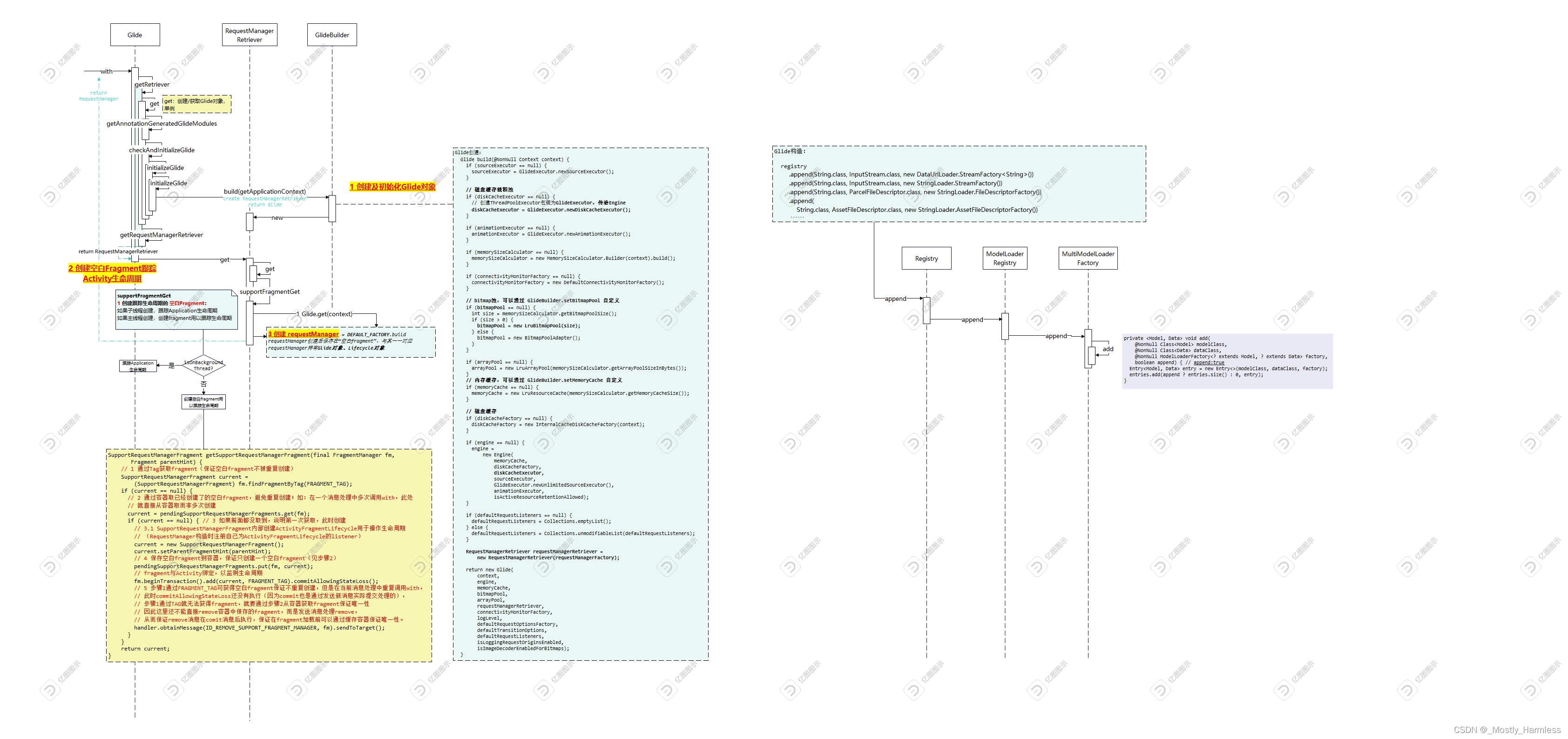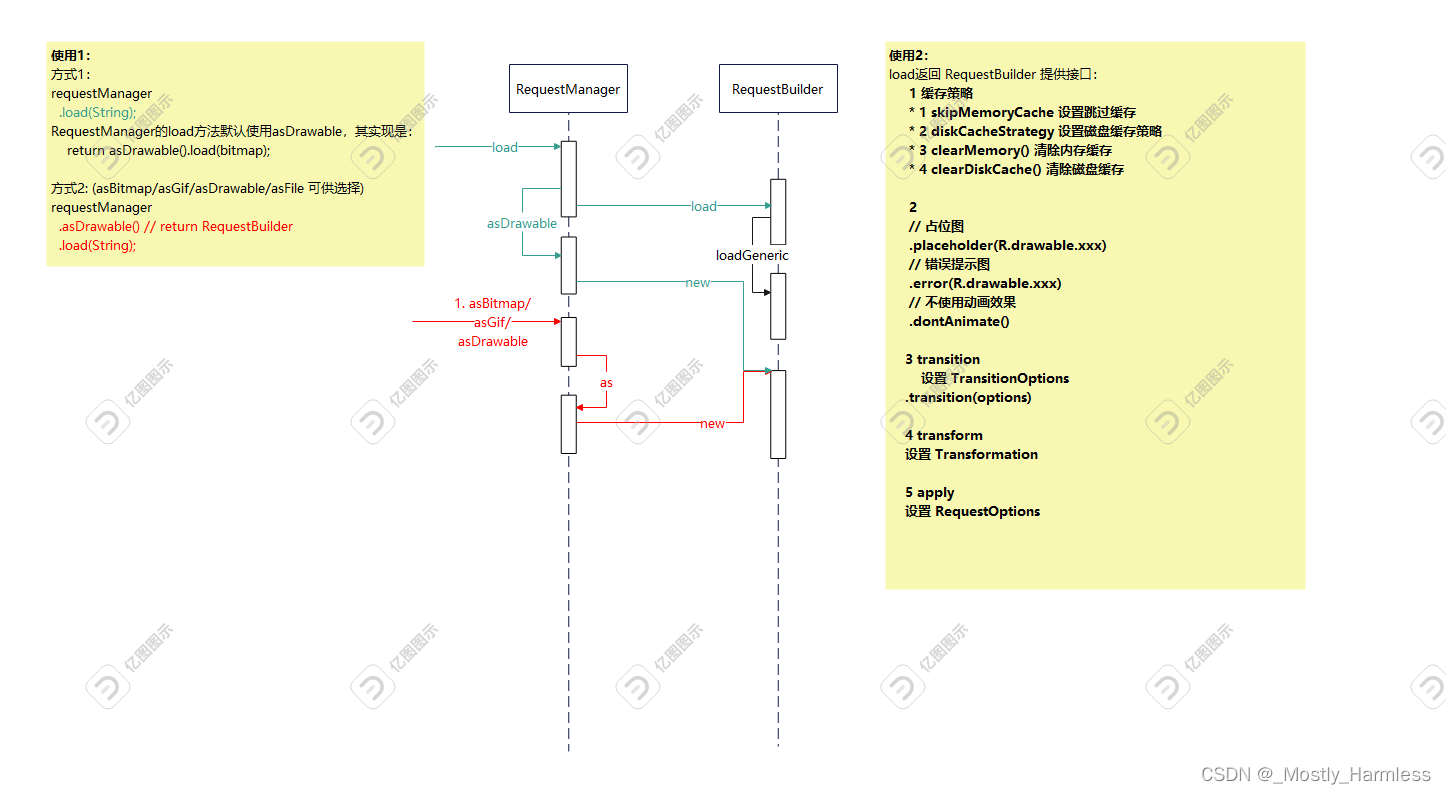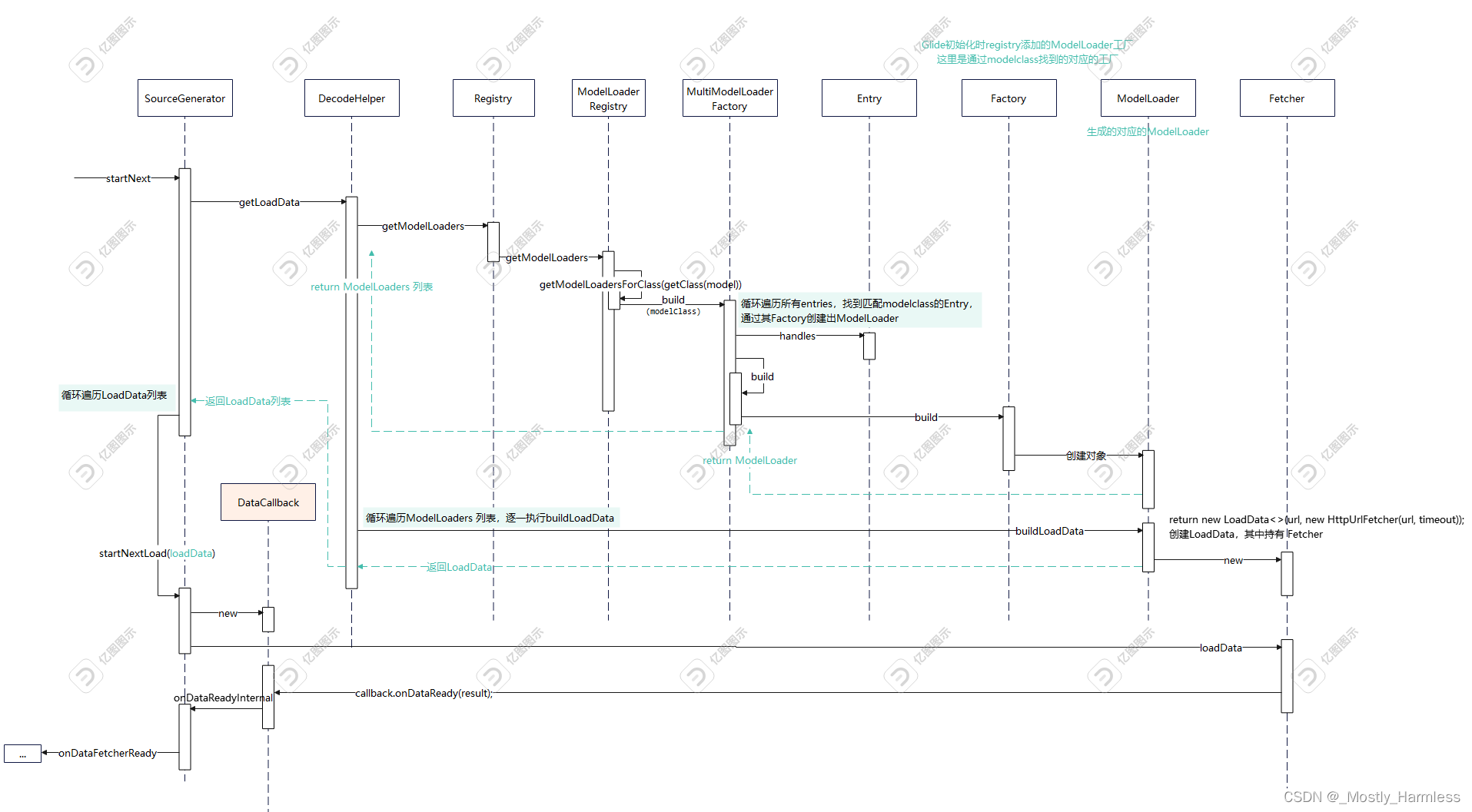本篇做Glide流程分析笔记,以打通主要流程为主。
从Glide基本使用入手:
1Glide.with(this).load(INTERNET_PIC_URL_1).into(imageView);
一、.with的处理
1 初始化Glide对象
1.1 初始化BitmapPool对象池、内存缓存、磁盘缓存、Engine处理引擎等并交给Glide。
1
2
3
4
5
6
7
8
9
10
11
12
13
14
15
16
17
18
19
20
21
22
23
24
25
26
27
28
29
30
31
32
33
34
35
36
37
38
39
40
41
42
43
44
45
46
47
48
49
50
51
52
53
54
55
56
57
58
59
60
61
62
63
64
65
66
67
68
69
70
71
72
73
74
75
76
77
78
79
80@NonNull Glide build(@NonNull Context context) { if (sourceExecutor == null) { sourceExecutor = GlideExecutor.newSourceExecutor(); } // 磁盘缓存处理器 if (diskCacheExecutor == null) { diskCacheExecutor = GlideExecutor.newDiskCacheExecutor(); } if (animationExecutor == null) { animationExecutor = GlideExecutor.newAnimationExecutor(); } if (memorySizeCalculator == null) { memorySizeCalculator = new MemorySizeCalculator.Builder(context).build(); } if (connectivityMonitorFactory == null) { connectivityMonitorFactory = new DefaultConnectivityMonitorFactory(); } // 对象池,bitmap复用 if (bitmapPool == null) { int size = memorySizeCalculator.getBitmapPoolSize(); if (size > 0) { bitmapPool = new LruBitmapPool(size); } else { bitmapPool = new BitmapPoolAdapter(); } } if (arrayPool == null) { arrayPool = new LruArrayPool(memorySizeCalculator.getArrayPoolSizeInBytes()); } // 内存缓存 if (memoryCache == null) { memoryCache = new LruResourceCache(memorySizeCalculator.getMemoryCacheSize()); } // 磁盘缓存 if (diskCacheFactory == null) { diskCacheFactory = new InternalCacheDiskCacheFactory(context); } if (engine == null) { // 任务处理引擎,负责调度获取图片的任务,包括对缓存的调度等。 engine = new Engine( memoryCache, diskCacheFactory, diskCacheExecutor, sourceExecutor, GlideExecutor.newUnlimitedSourceExecutor(), animationExecutor, isActiveResourceRetentionAllowed); } if (defaultRequestListeners == null) { defaultRequestListeners = Collections.emptyList(); } else { defaultRequestListeners = Collections.unmodifiableList(defaultRequestListeners); } RequestManagerRetriever requestManagerRetriever = new RequestManagerRetriever(requestManagerFactory); // 创建 Glide 对象 return new Glide( context, engine, memoryCache, bitmapPool, arrayPool, requestManagerRetriever, connectivityMonitorFactory, logLevel, defaultRequestOptionsFactory, defaultTransitionOptions, defaultRequestListeners, isLoggingRequestOriginsEnabled, isImageDecoderEnabledForBitmaps); }
1.2 注册组件,它的用途是根据使用者传入的资源类型规定对应的处理用的ModelLoader。
例如:
1.append(GlideUrl.class, InputStream.class, new HttpGlideUrlLoader.Factory())
GlideUrl.class 是使用者.load传入的类型
InputStream.class 需要返回的结果类型
如果符合1、2参数,则对应使用 HttpGlideUrlLoader 处理请求数据。
参数1:使用者load传入的资源地址类型;
参数2:需要返回的结果类型;
参数3:对应做处理的Loader的工厂,用以创建工作Loader。
1
2
3
4
5
6
7
8
9
10
11
12
13
14
15
16
17
18
19
20
21
22
23
24registry .append(int.class, InputStream.class, resourceLoaderStreamFactory) .append(int.class, ParcelFileDescriptor.class, resourceLoaderFileDescriptorFactory) .append(Integer.class, InputStream.class, resourceLoaderStreamFactory) .append(Integer.class, ParcelFileDescriptor.class, resourceLoaderFileDescriptorFactory) .append(Integer.class, Uri.class, resourceLoaderUriFactory) .append(int.class, AssetFileDescriptor.class, resourceLoaderAssetFileDescriptorFactory) .append(Integer.class, AssetFileDescriptor.class, resourceLoaderAssetFileDescriptorFactory) .append(int.class, Uri.class, resourceLoaderUriFactory) .append(String.class, InputStream.class, new DataUrlLoader.StreamFactory<String>()) .append(Uri.class, InputStream.class, new DataUrlLoader.StreamFactory<Uri>()) .append(String.class, InputStream.class, new StringLoader.StreamFactory()) .append(String.class, ParcelFileDescriptor.class, new StringLoader.FileDescriptorFactory()) .append( String.class, AssetFileDescriptor.class, new StringLoader.AssetFileDescriptorFactory()) .append(Uri.class, InputStream.class, new HttpUriLoader.Factory()) .append(Uri.class, InputStream.class, new AssetUriLoader.StreamFactory(context.getAssets())) .append( Uri.class, ParcelFileDescriptor.class, new AssetUriLoader.FileDescriptorFactory(context.getAssets())) .append(Uri.class, InputStream.class, new MediaStoreImageThumbLoader.Factory(context)) .append(Uri.class, InputStream.class, new MediaStoreVideoThumbLoader.Factory(context)); ...
1.3 创建ImageViewTargetFactory,用于后续创建ImageViewTarget。ImageViewTarget持有添加需要加载图片的目标控件,就是最终给控件设置资源的处理类。在后面.into讲解。
1
2
3
4
5
6
7
8
9
10
11
12
13ImageViewTargetFactory imageViewTargetFactory = new ImageViewTargetFactory(); glideContext = new GlideContext( context, arrayPool, registry, imageViewTargetFactory, defaultRequestOptionsFactory, defaultTransitionOptions, defaultRequestListeners, engine, isLoggingRequestOriginsEnabled, logLevel);
2 创建RequestManagerRetriever,生成空白Fragment用以跟踪Activity生命周期。
1
2
3
4
5
6
7
8
9
10
11
12
13
14
15
16
17
18
19
20
21
22
23
24
25
26
27
28SupportRequestManagerFragment getSupportRequestManagerFragment(final FragmentManager fm, Fragment parentHint) { // 1 通过Tag获取fragment(保证空白fragment不被重复创建) SupportRequestManagerFragment current = (SupportRequestManagerFragment) fm.findFragmentByTag(FRAGMENT_TAG); if (current == null) { // 2 通过容器取已经创建了的空白fragment,避免重复创建;如:在一个消息处理中多次调用with,此处 // 就直接从容器取而非多次创建 current = pendingSupportRequestManagerFragments.get(fm); if (current == null) { // 3 如果前面都没取到,说明第一次获取,此时创建 // 3.1 SupportRequestManagerFragment内部创建ActivityFragmentLifecycle用于操作生命周期 // (RequestManager构造时注册自己为ActivityFragmentLifecycle的listener) current = new SupportRequestManagerFragment(); current.setParentFragmentHint(parentHint); // 4 保存空白fragment到容器,保证只创建一个空白fragment(见步骤2) pendingSupportRequestManagerFragments.put(fm, current); // fragment与Activity绑定,以监测生命周期 fm.beginTransaction().add(current, FRAGMENT_TAG).commitAllowingStateLoss(); // 5 步骤1通过FRAGMENT_TAG可获得空白fragment保证不重复创建,但是在当前消息处理中重复调用with, // 此时commitAllowingStateLoss还没有执行(因为commit也是通过发送新消息实际提交处理的), // 步骤1通过TAG就无法获得fragment,就要通过步骤2从容器获取fragment保证唯一性 // 因此这里还不能直接remove容器中保存的fragment,而是发送消息处理remove, // 从而保证remove消息在comit消息后执行,保证在fragment加载前可以通过缓存容器保证唯一性。 handler.obtainMessage(ID_REMOVE_SUPPORT_FRAGMENT_MANAGER, fm).sendToTarget(); } } return current; }
此段代码是生成fragment并加载的过程,通过fragment TAG和缓存容器避免多次调用造成多次创建fragment。具体如何保证的,节选代码里注释已经写清楚了。
Fragment中ActivityFragmentLifecycle是用来监听生命周期的,具体如何发挥作用,在本文后边“四 Glide如何感知生命周期变化的” 有图解。
3 创建RequestManager,给生命周期fragment持有。
RequestManager是一个LifecycleListener,它在构造时把自己注册给Lifecycle从而达到感知生命周期的目的。
RequestManager内持有TargetTracker/RequestTracker用来管理target/request的生命周期。
1
2
3
4
5
6
7
8
9
10
11
12
13
14
15
16
17
18
19
20
21
22
23
24
25
26
27
28
29
30
31
32
33
34
35
36
37
38
39
40
41
42public final class TargetTracker implements LifecycleListener { private final Set<Target<?>> targets = Collections.newSetFromMap(new WeakHashMap<Target<?>, Boolean>()); // 注册 public void track(@NonNull Target<?> target) { targets.add(target); } public void untrack(@NonNull Target<?> target) { targets.remove(target); } @Override public void onStart() { for (Target<?> target : Util.getSnapshot(targets)) { target.onStart(); } } @Override public void onStop() { for (Target<?> target : Util.getSnapshot(targets)) { target.onStop(); } } @Override public void onDestroy() { for (Target<?> target : Util.getSnapshot(targets)) { target.onDestroy(); } } @NonNull public List<Target<?>> getAll() { return Util.getSnapshot(targets); } public void clear() { targets.clear(); } }
1
2
3
4
5
6
7
8
9
10
11
12
13
14
15
16
17
18
19
20
21
22
23
24
25
26
27
28
29
30
31public class RequestTracker { private static final String TAG = "RequestTracker"; private final Set<Request> requests = Collections.newSetFromMap(new WeakHashMap<Request, Boolean>()); @SuppressWarnings("MismatchedQueryAndUpdateOfCollection") private final List<Request> pendingRequests = new ArrayList<>(); private boolean isPaused; /** Starts tracking the given request. */ public void runRequest(@NonNull Request request) { requests.add(request); if (!isPaused) { request.begin(); } else { request.clear(); if (Log.isLoggable(TAG, Log.VERBOSE)) { Log.v(TAG, "Paused, delaying request"); } pendingRequests.add(request); } } // 注册 @VisibleForTesting void addRequest(Request request) { requests.add(request); } ...
Glide如何通过fragment生命周期控制操作的呢?

SupportRequestManagerFragment被加载到Activity,它持有ActivityFragmentLifecycle,通过这个Lifecycle通知监听者生命周期的变化。
RequestManager是一个Lifecycle,它在构造时注册自己监听ActivityFragmentLifecycle。RequestManager持有一个TargetTracker和RequestTracker,分别跟踪处理Target和Request,Target和Request注册后就可以依赖RequestManager感知生命周期变化了。
with处理流程图:

二、load处理流程
1 加载资源来源,通过load传入数据来源:可传入网络URL地址、本地地址等;设置类型:asBitmap/asGif/asDrawable/asFile
2 load返回RequestBuilder,提供了一些接口方便使用者自定义:
缓存策略设置:
* 1 skipMemoryCache 设置跳过缓存
* 2 diskCacheStrategy 设置磁盘缓存策略
* 3 clearMemory() 清除内存缓存
* 4 clearDiskCache() 清除磁盘缓存
2 风格设置:
.placeholder(R.drawable.xxx) 设置占位图
.error(R.drawable.xxx) 设置错误提示图
.dontAnimate() 设置不使用动画效果
3 自定义定制图片风格
.transition(TransitionOptions) 使用者可以通过自定义TransitionOptions对图片风格进行加工。

三、into处理流程
前面是对Glide的初始化准备工作,这里才是触发Glide真正工作的地方。
1.1 into传入了目标控件,根据传入的目标ImageView的ScaleType获取Glide的压缩策略requestOptions,Glide有一套自己的压缩策略,会在其他文章另外讲解。
1.2 创建一个ViewTarget,持有目标控件,负责最终对控件加载资源等操作。
1
2
3
4
5
6
7
8
9
10
11
12
13
14
15
16
17
18
19
20
21
22
23
24
25
26
27
28
29
30
31
32
33
34
35
36
37
38
39
40
41public ViewTarget<ImageView, TranscodeType> into(@NonNull ImageView view) { Util.assertMainThread(); Preconditions.checkNotNull(view); BaseRequestOptions<?> requestOptions = this; if (!requestOptions.isTransformationSet() && requestOptions.isTransformationAllowed() && view.getScaleType() != null) { // Clone in this method so that if we use this RequestBuilder to load into a View and then // into a different target, we don't retain the transformation applied based on the previous // View's scale type. // 1.1 根据ScaleType获取Glide自己的压缩策略 switch (view.getScaleType()) { case CENTER_CROP: requestOptions = requestOptions.clone().optionalCenterCrop(); break; case CENTER_INSIDE: requestOptions = requestOptions.clone().optionalCenterInside(); break; case FIT_CENTER: case FIT_START: case FIT_END: requestOptions = requestOptions.clone().optionalFitCenter(); break; case FIT_XY: requestOptions = requestOptions.clone().optionalCenterInside(); break; case CENTER: case MATRIX: default: // Do nothing. } } return into( // 1.2 创建ViewTarget,用以处理最终加载图片到目标控件上。 glideContext.buildImageViewTarget(view, transcodeClass), /*targetListener=*/ null, requestOptions, Executors.mainThreadExecutor()); }
2 创建Request,注册Target和Request给requestManager管理。
1
2
3
4
5
6
7
8
9
10
11
12
13
14
15
16
17
18
19
20
21
22
23
24
25
26
27
28
29private <Y extends Target<TranscodeType>> Y into( @NonNull Y target, @Nullable RequestListener<TranscodeType> targetListener, BaseRequestOptions<?> options, Executor callbackExecutor) { Preconditions.checkNotNull(target); if (!isModelSet) { throw new IllegalArgumentException("You must call #load() before calling #into()"); } // 创建Requst Request request = buildRequest(target, targetListener, options, callbackExecutor); Request previous = target.getRequest(); if (request.isEquivalentTo(previous) && !isSkipMemoryCacheWithCompletePreviousRequest(options, previous)) { if (!Preconditions.checkNotNull(previous).isRunning()) { previous.begin(); } return target; } requestManager.clear(target); // request交给ImageViewTarget target.setRequest(request); // target交给targetTracker,request交给requestTracker requestManager.track(target, request); return target; }
3 Engine.load启动图片加载,Engine是所有任务的整体调度引擎。
1
2
3
4
5
6
7
8
9
10
11
12
13
14
15
16
17
18
19
20
21
22
23
24
25
26
27
28
29
30
31
32
33
34
35
36
37
38
39
40
41
42
43
44
45
46
47
48
49
50
51
52
53
54
55
56
57
58
59
60
61
62
63
64
65
66
67public <R> LoadStatus load( GlideContext glideContext, Object model, Key signature, int width, int height, Class<?> resourceClass, Class<R> transcodeClass, Priority priority, DiskCacheStrategy diskCacheStrategy, Map<Class<?>, Transformation<?>> transformations, boolean isTransformationRequired, boolean isScaleOnlyOrNoTransform, Options options, boolean isMemoryCacheable, boolean useUnlimitedSourceExecutorPool, boolean useAnimationPool, boolean onlyRetrieveFromCache, ResourceCallback cb, Executor callbackExecutor) { long startTime = VERBOSE_IS_LOGGABLE ? LogTime.getLogTime() : 0; EngineKey key = keyFactory.buildKey( model, signature, width, height, transformations, resourceClass, transcodeClass, options); EngineResource<?> memoryResource; synchronized (this) { // 3.1 查找缓存 memoryResource = loadFromMemory(key, isMemoryCacheable, startTime); if (memoryResource == null) { // 3.2 缓存未命中,继续后续策略 return waitForExistingOrStartNewJob( glideContext, model, signature, width, height, resourceClass, transcodeClass, priority, diskCacheStrategy, transformations, isTransformationRequired, isScaleOnlyOrNoTransform, options, isMemoryCacheable, useUnlimitedSourceExecutorPool, useAnimationPool, onlyRetrieveFromCache, cb, callbackExecutor, key, startTime); } } // 查询缓存命中 cb.onResourceReady(memoryResource, DataSource.MEMORY_CACHE); return null; }
3.1 查询memory缓存:先查询活动缓存,命中直接返回结果,否则查询内存缓存。
1
2
3
4
5
6
7
8
9
10
11
12
13
14
15
16
17
18
19
20
21
22
23
24
25
26private EngineResource<?> loadFromMemory( EngineKey key, boolean isMemoryCacheable, long startTime) { if (!isMemoryCacheable) { return null; } // 活动缓存 EngineResource<?> active = loadFromActiveResources(key); if (active != null) { if (VERBOSE_IS_LOGGABLE) { logWithTimeAndKey("Loaded resource from active resources", startTime, key); } // 命中直接返回 return active; } // 内存缓存 EngineResource<?> cached = loadFromCache(key); if (cached != null) { if (VERBOSE_IS_LOGGABLE) { logWithTimeAndKey("Loaded resource from cache", startTime, key); } // 命中直接返回 return cached; } return null; }
如果内存缓存命中,则调用Request onResourceReady通知资源就绪,Request会使用ViewTarget给控件加载内容。
如果没有命中则继续后续策略,查找磁盘缓存(如果没有被使用者禁用)
3.2 磁盘缓存
1
2
3
4
5
6
7
8
9
10
11
12
13
14
15
16
17
18
19
20
21
22
23
24
25
26
27
28
29
30
31
32
33
34
35
36
37
38
39
40
41
42
43
44
45
46
47
48
49
50
51
52
53
54
55
56
57
58
59
60
61
62
63
64
65
66
67
68
69
70private <R> LoadStatus waitForExistingOrStartNewJob( GlideContext glideContext, Object model, Key signature, int width, int height, Class<?> resourceClass, Class<R> transcodeClass, Priority priority, DiskCacheStrategy diskCacheStrategy, Map<Class<?>, Transformation<?>> transformations, boolean isTransformationRequired, boolean isScaleOnlyOrNoTransform, Options options, boolean isMemoryCacheable, boolean useUnlimitedSourceExecutorPool, boolean useAnimationPool, boolean onlyRetrieveFromCache, ResourceCallback cb, Executor callbackExecutor, EngineKey key, long startTime) { EngineJob<?> current = jobs.get(key, onlyRetrieveFromCache); if (current != null) { current.addCallback(cb, callbackExecutor); if (VERBOSE_IS_LOGGABLE) { logWithTimeAndKey("Added to existing load", startTime, key); } return new LoadStatus(cb, current); } EngineJob<R> engineJob = engineJobFactory.build( key, isMemoryCacheable, useUnlimitedSourceExecutorPool, useAnimationPool, onlyRetrieveFromCache); DecodeJob<R> decodeJob = decodeJobFactory.build( glideContext, model, key, signature, width, height, resourceClass, transcodeClass, priority, diskCacheStrategy, transformations, isTransformationRequired, isScaleOnlyOrNoTransform, onlyRetrieveFromCache, options, engineJob); jobs.put(key, engineJob); engineJob.addCallback(cb, callbackExecutor); // 启动任务 decodeJob engineJob.start(decodeJob); if (VERBOSE_IS_LOGGABLE) { logWithTimeAndKey("Started new load", startTime, key); } return new LoadStatus(cb, engineJob); }
3.2.1 启动decodeJob
1
2
3
4
5
6public synchronized void start(DecodeJob<R> decodeJob) { this.decodeJob = decodeJob; GlideExecutor executor = decodeJob.willDecodeFromCache() ? diskCacheExecutor : getActiveSourceExecutor(); executor.execute(decodeJob); }
1
2
3
4boolean willDecodeFromCache() { Stage firstStage = getNextStage(Stage.INITIALIZE); return firstStage == Stage.RESOURCE_CACHE || firstStage == Stage.DATA_CACHE; }
1
2
3
4
5
6
7
8
9
10
11
12
13
14
15
16
17
18
19private Stage getNextStage(Stage current) { switch (current) { case INITIALIZE: return diskCacheStrategy.decodeCachedResource() ? Stage.RESOURCE_CACHE : getNextStage(Stage.RESOURCE_CACHE); case RESOURCE_CACHE: return diskCacheStrategy.decodeCachedData() ? Stage.DATA_CACHE : getNextStage(Stage.DATA_CACHE); case DATA_CACHE: return onlyRetrieveFromCache ? Stage.FINISHED : Stage.SOURCE; case SOURCE: case FINISHED: return Stage.FINISHED; default: throw new IllegalArgumentException("Unrecognized stage: " + current); } }
可以看到willDecodeFromCache通过getNextStage获取firstStage,判断当前firstStage是RESOURCE_CACHE / DATA_CACHE则使用diskCacheExecutor。
通过getNextStage可以看出,Stage取决于diskCacheStrategy的decodeCachedResource decodeCachedData这两个方法。
DiskCacheStrategy提供了5个实现,策略详情如下:

使用者如果没有设置,默认使用的是AUTOMATIV,则可以看出willDecodeFromCache返回true,选用diskCacheExecutor execute(decodeJob); 执行decodeJob。
1
2
3
4
5
6
7
8
9
10
11
12
13
14
15
16
17
18
19
20
21private void runWrapped() { // 初始状态是INITIALIZE switch (runReason) { case INITIALIZE: // 1 取策略 stage = getNextStage(Stage.INITIALIZE); // 2 取策略对应处理器 currentGenerator = getNextGenerator(); // 3 执行 runGenerators(); break; case SWITCH_TO_SOURCE_SERVICE: runGenerators(); break; case DECODE_DATA: decodeFromRetrievedData(); break; default: throw new IllegalStateException("Unrecognized run reason: " + runReason); } }
decodeJob任务run->runWrapped,这里使用的状态模式做处理,根据当前状态取对应策略做处理。
runReason初始状态是INITIALIZE,
1> 执行getNextStage(Stage.INITIALIZE);取策略状态,参考前面的getNextStage分析,使用默认策略是AUTOMATIV调用getNextStage返回stage = Stage.RESOURCE_CACHE,
2> getNextGenerator根据RESOURCE_CACHE生成ResourceCacheGenerator,currentGenerator = new ResourceCacheGenerator
1
2
3
4
5
6
7
8
9
10
11
12
13
14
15private DataFetcherGenerator getNextGenerator() { switch (stage) { // stage == RESOURCE_CACHE case RESOURCE_CACHE: return new ResourceCacheGenerator(decodeHelper, this); case DATA_CACHE: return new DataCacheGenerator(decodeHelper, this); case SOURCE: return new SourceGenerator(decodeHelper, this); case FINISHED: return null; default: throw new IllegalStateException("Unrecognized stage: " + stage); } }
3> runGenerators执行策略,这里循环遍历执行策略,未命中就找下一策略继续执行,命中即跳出。
1
2
3
4
5
6
7
8
9
10
11
12
13
14
15
16
17
18
19
20
21
22private void runGenerators() { currentThread = Thread.currentThread(); startFetchTime = LogTime.getLogTime(); boolean isStarted = false; // currentGenerator.startNext执行,若执行不命中返回false进入循环体,获取下一个策略继续执行 // 这里的逻辑就是遍历执行所有的策略。 while (!isCancelled && currentGenerator != null && !(isStarted = currentGenerator.startNext())) { stage = getNextStage(stage); currentGenerator = getNextGenerator(); if (stage == Stage.SOURCE) { reschedule(); return; } } // 走到这里stage是FINISHED表示遍历了所有策略均未命中,失败。 if ((stage == Stage.FINISHED || isCancelled) && !isStarted) { notifyFailed(); } }
循环遍历会依次获取如下三个Generator执行startNext:
ResourceCacheGenerator 解码后的缓存
DataCacheGenerator 源数据缓存
SourceGenerator 从数据源重新获取
我们假设缓存均为命中(缓存策略另起文章,本文为打通整体流程)会一直执行到SourceGenerator的startNext。
4 从数据源获取数据:
SourceGenerator startNext其实就是要从实际数据源获取数据。它是怎么做的呢?在前面讲解with初始化Glide时讲到Glide通过Registry保存了许多如下的数据源地址和ModelLoader的对应关系,这里就是通过使用者传入的数据源类型根据Registry保存的关系生成ModelLoader做处理的。
1.append(GlideUrl.class, InputStream.class, new HttpGlideUrlLoader.Factory())
.append的数据最终是以Entry数据结构存储在MultiModelLoaderFactory:
1
2
3
4
5
6
7
8private <Model, Data> void add( @NonNull Class<Model> modelClass, @NonNull Class<Data> dataClass, @NonNull ModelLoaderFactory<? extends Model, ? extends Data> factory, boolean append) { Entry<Model, Data> entry = new Entry<>(modelClass, dataClass, factory); entries.add(append ? entries.size() : 0, entry); }
获取数据的操作者DataLoader,是通过Registry获取与使用者传入的数据源的地址类型匹配的ModelLoadFactory,由factory生成对应的ModelLoad,ModelLoad再生成自己的DataLoader。DataLoader其中包含真正做事的fetcher,最终通过fetcher获取数据:
1
2
3
4
5
6
7
8
9
10
11
12
13
14
15
16
17
18
19
20
21
22
23
24
25
26
27public boolean startNext() { if (dataToCache != null) { Object data = dataToCache; dataToCache = null; cacheData(data); } if (sourceCacheGenerator != null && sourceCacheGenerator.startNext()) { return true; } sourceCacheGenerator = null; loadData = null; boolean started = false; while (!started && hasNextModelLoader()) { // 1 取LoadData loadData = helper.getLoadData().get(loadDataListIndex++); if (loadData != null && (helper.getDiskCacheStrategy().isDataCacheable(loadData.fetcher.getDataSource()) || helper.hasLoadPath(loadData.fetcher.getDataClass()))) { started = true; // 2 已经生成并获取到了LoadData,开始使用LoadData实际获取数据 startNextLoad(loadData); } } return started; }
1 尝试获取LoadData,LoadData是获取源数据的实际操作者,其中包含Fetcher用于实际操作。
1
2
3
4
5
6
7
8
9
10
11
12
13
14
15
16
17List<LoadData<?>> getLoadData() { if (!isLoadDataSet) { isLoadDataSet = true; loadData.clear(); // 1.1 通过mode类型获取到对应的所有的ModelLoader List<ModelLoader<Object, ?>> modelLoaders = glideContext.getRegistry().getModelLoaders(model); for (int i = 0, size = modelLoaders.size(); i < size; i++) { ModelLoader<Object, ?> modelLoader = modelLoaders.get(i); // 1.2 通过ModelLoader生成LoadData LoadData<?> current = modelLoader.buildLoadData(model, width, height, options); if (current != null) { loadData.add(current); } } } return loadData; }
1.1 通过model类型获取ModelLoader,ModelLoader可以创建自己的LoadData。
1
2
3
4
5
6
7
8
9
10
11
12
13
14
15
16
17
18
19
20
21
22
23
24
25
26
27
28
29
30
31
32
33
34
35
36public <A> List<ModelLoader<A, ?>> getModelLoaders(@NonNull A model) { List<ModelLoader<A, ?>> modelLoaders = getModelLoadersForClass(getClass(model)); if (modelLoaders.isEmpty()) { throw new NoModelLoaderAvailableException(model); } int size = modelLoaders.size(); boolean isEmpty = true; List<ModelLoader<A, ?>> filteredLoaders = Collections.emptyList(); //noinspection ForLoopReplaceableByForEach to improve perf for (int i = 0; i < size; i++) { ModelLoader<A, ?> loader = modelLoaders.get(i); if (loader.handles(model)) { if (isEmpty) { filteredLoaders = new ArrayList<>(size - i); isEmpty = false; } filteredLoaders.add(loader); } } if (filteredLoaders.isEmpty()) { throw new NoModelLoaderAvailableException(model, modelLoaders); } return filteredLoaders; } @NonNull private synchronized <A> List<ModelLoader<A, ?>> getModelLoadersForClass( @NonNull Class<A> modelClass) { List<ModelLoader<A, ?>> loaders = cache.get(modelClass); if (loaders == null) { // 根据modelClass从Entrys取loaders loaders = Collections.unmodifiableList(multiModelLoaderFactory.build(modelClass)); cache.put(modelClass, loaders); } return loaders; }
遍历所有Entry,找到匹配的Factory创建出对应的ModelLoader实例。
1
2
3
4
5
6
7
8
9
10
11
12
13
14
15
16
17
18
19
20
21
22
23
24
25
26synchronized <Model> List<ModelLoader<Model, ?>> build(@NonNull Class<Model> modelClass) { try { List<ModelLoader<Model, ?>> loaders = new ArrayList<>(); // 遍历所有Entrys for (Entry<?, ?> entry : entries) { // Avoid stack overflow recursively creating model loaders by only creating loaders in // recursive requests if they haven't been created earlier in the chain. For example: // A Uri loader may translate to another model, which in turn may translate back to a Uri. // The original Uri loader won't be provided to the intermediate model loader, although // other Uri loaders will be. if (alreadyUsedEntries.contains(entry)) { continue; } if (entry.handles(modelClass)) { alreadyUsedEntries.add(entry); // build去创建Loader,因为Entry里方的是工厂,这里是通过工厂创建实际对象。 loaders.add(this.<Model, Object>build(entry)); alreadyUsedEntries.remove(entry); } } return loaders; } catch (Throwable t) { alreadyUsedEntries.clear(); throw t; } }
1.2 通过ModelLoader生成LoadData(以HttpGlideUrlLoader为例)
1
2
3
4
5
6
7
8
9
10
11
12
13
14
15
16
17@Override public LoadData<InputStream> buildLoadData( @NonNull GlideUrl model, int width, int height, @NonNull Options options) { // GlideUrls memoize parsed URLs so caching them saves a few object instantiations and time // spent parsing urls. GlideUrl url = model; if (modelCache != null) { url = modelCache.get(model, 0, 0); if (url == null) { modelCache.put(model, 0, 0, model); url = model; } } int timeout = options.get(TIMEOUT); // 生成LoadData和HttpUrlFetcher return new LoadData<>(url, new HttpUrlFetcher(url, timeout)); }
2 LoadData已经生成,fetcher.loadData开始实际工作并传入回调用以感知运行结果:
1
2
3
4
5
6
7
8
9
10
11
12
13
14
15
16
17
18
19
20private void startNextLoad(final LoadData<?> toStart) { // 实际是调用fetcher loadData.fetcher.loadData( helper.getPriority(), new DataCallback<Object>() { @Override public void onDataReady(@Nullable Object data) { if (isCurrentRequest(toStart)) { onDataReadyInternal(toStart, data); } } @Override public void onLoadFailed(@NonNull Exception e) { if (isCurrentRequest(toStart)) { onLoadFailedInternal(toStart, e); } } }); }
做完事情后回调DataCallback的onDataReady通知完成。
1
2
3
4
5
6
7
8
9
10
11
12
13
14
15
16
17
18
19public void loadData( @NonNull Priority priority, @NonNull DataCallback<? super InputStream> callback) { long startTime = LogTime.getLogTime(); try { // Doing... InputStream result = loadDataWithRedirects(glideUrl.toURL(), 0, null, glideUrl.getHeaders()); // 成功,回调通知 callback.onDataReady(result); } catch (IOException e) { if (Log.isLoggable(TAG, Log.DEBUG)) { Log.d(TAG, "Failed to load data for url", e); } callback.onLoadFailed(e); } finally { if (Log.isLoggable(TAG, Log.VERBOSE)) { Log.v(TAG, "Finished http url fetcher fetch in " + LogTime.getElapsedMillis(startTime)); } } }
整体流程如图:

这里以请求网络资源为例,则会调用到HttpUrlFetcher请求网络,成功后回调传回结果。
回调EncodeJob onResourceDecoded,放入本地磁盘缓存。
Engine接收到EngineJobe完成的回调,会把结果放入活动缓存。
这里开始切换回主线程,开始着手把图片加载到控件了。EngineJobe回调SingleRequest onResourceReady,SingleRequest 持有着ImageViewTarget,这就把资源加载到控件了。
.into完整流程图:

总体来讲:
使用者调用.with,传入数据来源,这里主要是对Glide做初始化准备工作,主要包括监控生命周期的空白Fragment的创建;
.load主要提供了各种个性化配置;
.into传入目标控件,是glide真正启动的入口,这里开始实际请求数据加载到控件,其中包含了数据缓存、对象复用、图片压缩等。
最后
以上就是耍酷溪流最近收集整理的关于【笔记】开源框架 - Glide(三):代码流程分析的全部内容,更多相关【笔记】开源框架内容请搜索靠谱客的其他文章。








发表评论 取消回复